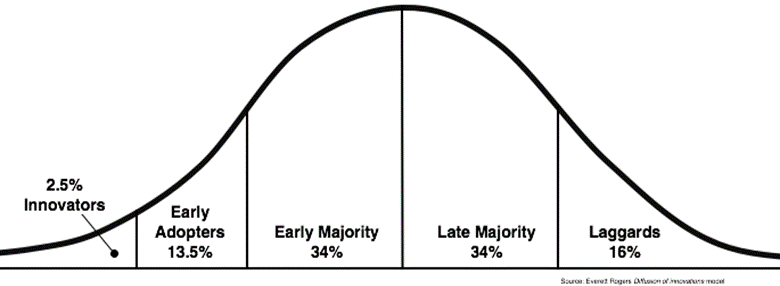Innovation adoption is a crucial challenge forward-thinking organisations must face to maintain a competitive edge. However, understanding the stages of innovation adoption can help organisations navigate the process and target the right groups of adopters. Let’s explore these stages and how businesses can overcome resistance within or without their organisation.
The Five Stages of Innovation Adoption
To better understand the five stages of innovation adoption, we should look at Everett Roger’s bell-shaped curve or the diffusion of innovation theory. This theory divides innovation adoption into five stages, each with its own unique characteristics.
Innovators, for example, are typically the first to embrace new ideas, while early adopters set the pace for others to follow. On the other hand, the early majority plays a critical role in the success of any innovation adoption strategies, while the late majority wants to see further evidence before embracing a new idea. Finally, laggards are those most resistant to change, being more comfortable in their comfort zone and preferring to maintain the status quo in their industry. Let’s look closely at the adopter categories and what they entail.

The Innovators: Who Are They and Why Are They Important?
Innovators are the first to adopt new ideas, products, or technologies. They are typically risk-takers who enjoy experimentation and trying out new things. Innovators are unsatisfied with the status quo and constantly look for ways to improve and enhance their work.
Innovation often begins with innovators willing to take a chance on a new idea, despite the risks and uncertainties that come with it. They are independent thinkers who challenge the norms and are unafraid to fail. Innovators can be found in every industry and can be crucial in driving innovation forward.
Organisations that want to introduce new ideas and products should target innovators first. They can provide valuable feedback on the product, which can help refine and improve it. They can also act as early adopters and influence others to adopt the product or technology. Innovators can be used as a resource for testing and refining the product, which can help organisations save time and money.
In addition, innovators can help organisations stay ahead of the competition. By embracing new ideas and technologies early on, innovators can give organisations a competitive advantage. They can also help organisations remain relevant in their respective industries by constantly seeking out new opportunities and ways to improve.
The Early Adopters: What Role Do They Play?

The second group in line to adopt an innovation is the early adopters. They are usually opinion leaders in their social networks and are highly respected members of their organisations. Early adopters are the people who take calculated risks and adopt new ideas before the majority of the population.
Early adopters play a crucial role in the diffusion of innovations because they act as a bridge between the innovators and the early majority. They help to create a buzz about new ideas and are instrumental in persuading the early majority to adopt innovations. They often have a higher social status than the average organisation member, and their peers highly value their opinion. Early adopters are also more likely to have higher levels of education and a greater capacity for risk-taking than the early majority.
Early adopters are essential to any innovation adoption’s success because they prove the innovation is viable and useful. They are typically more receptive to new ideas and are willing to experiment with them to see how they can be applied to their work. Early adopters are also more likely to give feedback on the innovation, which can be used to refine it and make it more appealing to the early majority.
Organisations that want to introduce new ideas should target early adopters after the innovators. They must identify who the early adopters are and provide them with the resources to try these new ideas. This could include providing training, support, and incentives for early adopters. Organisations can also create a network of early adopters who can share their experiences and help to spread the word about new ideas.
The Early Majority: What Do They Need?
The early majority represents the largest group of adopters, comprising approximately 34% of the population. This group is more cautious and deliberate than early adopters, requiring more evidence and information before embracing new ideas or technologies. They are more risk-averse than innovators and early adopters and tend to be more practical in their approach to change.
Early majority adopters are more likely to be motivated by a desire to improve their efficiency, productivity, or competitive position in the market rather than by a passion for innovation. They are typically not interested in being the first to try something new. However, they prefer the evidence of its success and stability before committing to it.
For organisations seeking to introduce something new, the key to convincing the early majority is to provide ample evidence of its potential benefits and long-term value. This group is more likely to be swayed by data, testimonials, and case studies from other organisations that have successfully adopted this type of innovation.
To address the needs of the early majority, organisations should focus on developing clear and concise messaging about this innovation and its potential impact on the organisation. They should also provide opportunities for early majority adopters to try the innovation in a controlled environment and offer support and training to ensure a smooth transition.
The Late Majority: Why Are They Skeptical?

The late majority is the fourth group in the innovation adoption process, consisting of those who adopt new ideas after the early majority. They are more sceptical about new ideas and require more evidence before embracing them. They tend to be more cautious and are not usually the first to try out new products or services. However, they prefer to wait and see how the innovation works for others before deciding.
One of the reasons why the late majority is sceptical is that they are more risk-averse than the early majority. They want to avoid making mistakes and are unwilling to take risks unless they are confident that the benefits of the innovation outweigh the risks. Therefore, organisations that want to introduce new ideas to the late majority must be prepared to provide strong evidence of the benefits of the innovation and mitigate any potential risks.
Another reason the late majority is sceptical is that they tend to be more conservative in their thinking and behaviour. They are often more attached to traditional ways of doing things, and thus they may view new ideas as threatening their established routines. Therefore, they may need more convincing that the new idea will not disrupt their existing workflow but will enhance it. Thus, organisations that want to introduce new ideas to the late majority must communicate the innovation’s benefits and show how it can improve their work.
The Laggards: How Can Organisations Target Them?
The laggards are the last group of adopters in the innovation adoption process. They are very resistant to change and slow to adopt new ideas. They often prefer to stick to the status quo and resist change, making it difficult for organisations to introduce new innovations successfully.
Laggards are typically older, less educated, and less technologically savvy than other adopters. They are often sceptical of new ideas and prefer to rely on traditional methods that have worked for them in the past. Because of their reluctance to embrace change, laggards can be a significant roadblock to successful innovation adoption.
To target laggards, organisations must first understand their needs and concerns. They may require additional support and training to help them understand how new ideas can benefit them. Organisations should also emphasise the potential benefits of innovation in language that resonates with the laggards.
Organisations should be patient with laggards. It can take longer for them to adopt new ideas, and they may require more evidence and convincing than other adopters. However, once they are convinced, laggards can become strong advocates for the innovation and help to promote it to others in the organisation.
Innovation Resistance: Why Do People Resist Innovation?

Innovation adoption is not only relevant for marketing purposes, but it is also a thing inside organisations. Even in the most innovative businesses, not all employees are open to changing their working ways. This is what we call innovation resistance and refers to the reluctance or opposition that employees may show towards adopting new ideas, technologies, or processes within their organisation. It is a common phenomenon and can hinder an organisation’s ability to innovate and adapt to changing market conditions.
There are several reasons why employees may resist innovation:
- Fear of the unknown: Employees may feel uncertain about how the new idea or technology will impact their job or the organisation as a whole. They may worry about job security or whether they can learn and adapt to the new technology or process.
- Lack of motivation: Employees may resist innovation if they do not see the value or benefits of the new idea or technology. They may be comfortable with the current way of doing things and not see the need for change.
- Lack of skills: Employees may not have the necessary skills or training to adopt and use the new technology or process. They may feel overwhelmed or frustrated by the learning curve required to master the new skills.
- Resistance to change: Some employees may resist change and prefer to stick with the status quo. They may be comfortable with the current way of doing things and feel that the new idea or technology is unnecessary or disruptive.
- Communication breakdown: In some cases, innovation resistance may be caused by a lack of communication or understanding between employees and management. Employees may not fully understand the goals and benefits of the new idea or technology, leading to scepticism and resistance.
Organisations must address these concerns and overcome innovation resistance to adopt new ideas and technologies successfully. They can achieve this through effective communication, training, and incentives to encourage employees to embrace change.
How To Overcome Innovation Resistance
Having seen why employees may be afraid of innovations, we should look at how organisations can overcome innovation resistance and encourage employees to embrace innovation. To do this, there are several steps organisations can take:
Provide Adequate Training and Support
Employees may resist new ideas or changes due to a lack of skills or knowledge. To address this, organisations can provide adequate employee training and support, such as workshops, mentoring programs, and online courses. Employees will be better equipped to embrace new ideas by enhancing their skills and knowledge.
Involve Employees in the Innovation Process
By involving employees in the innovation process, organisations can create a sense of ownership and buy-in among employees. This can be done by soliciting employee ideas and feedback, setting up innovation committees or groups, or encouraging cross-functional collaboration. Employees who feel that their ideas and contributions are valued are more likely to embrace new ideas and changes.
Provide Incentives
Organisations can also provide incentives for employees who embrace new ideas and changes. This can be in the form of monetary rewards, promotions, or recognition programs. By incentivising innovation, organisations can create a culture of innovation where employees are motivated to embrace new ideas.
Communicate the Benefits of Innovation
Organisations should communicate the benefits of innovation and how it can improve their employees’ work. This can be done through internal communications, such as newsletters, company-wide meetings, or training sessions. By highlighting the benefits of innovation, organisations can create a sense of excitement and enthusiasm among employees.
Lead by Example
Finally, organisations should lead by example and demonstrate a commitment to innovation at all levels. This can be done by setting innovation goals and objectives, allocating resources to innovation initiatives, and encouraging a culture of experimentation and risk-taking. When employees see that innovation is a top priority for the organisation, they are more likely to embrace new ideas and changes.
Conclusion
In today’s fast-paced business environment, innovation is essential for any organisation that wants to succeed. Embracing innovation can lead to a competitive advantage, improved efficiency, increased productivity, and enhanced customer satisfaction.
However, innovation adoption is an ongoing process that requires continuous effort and attention. Organisations must understand the stages of innovation adoption and the characteristics of the different adopter categories to target them effectively.
Furthermore, innovation resistance is a common phenomenon that can hinder the adoption of new ideas or changes. To overcome innovation resistance, organisations must address employees’ concerns, provide training and support, and communicate the benefits of innovation.
Organisations that want to stay relevant in their respective industries must continuously innovate and embrace new ideas. By targeting the right adopter categories, overcoming resistance, and encouraging employees to embrace innovation, organisations can successfully adopt new ideas and stay ahead of the competition.
At JOIST Innovation Park, we want to help innovation grow at all levels. Join the JOIST Park Community today and connect with other like-minded individuals and businesses! Share your ideas, get feedback, and collaborate with others to drive innovation and growth. Don’t miss out on this opportunity to be a part of a dynamic and supportive community. Sign up now!

